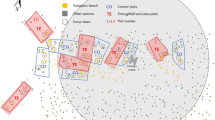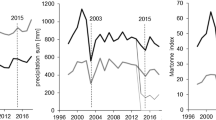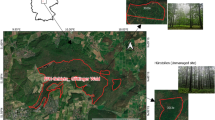Abstract
Key message
Root trenching of Norway spruce and European beech caused no long-term decrease of stem growth and only temporal growth reductions in European beech.
Abstract
Root volume reduction is a common occurrence in silvicultural, urban, and scientific environments, often the direct result of trenching applications. Although this interference is widespread near forest roads and in rural and urban areas, trees’ growth reactions to these limitations have rarely been analysed. Here, we compare the growth of 81 mature Norway spruce (Picea abies [L.] Karst) and European beech (Fagus sylvatica [L.]) trees, trenched for an experiment down to 1 m depth in a Luvisol soil (Parabraunerde) in 2010, and compared with 69 untrenched trees. The trenching was conducted prior to a long-term precipitation-exclusion treatment in a temperate mixed forest in Southern Germany. Stem and crown sizes, tree positions, distance to the trench, and annual stem growth of the 150 trees were measured from 2006 through 2013. Statistical analysis revealed that (1) stem growth reduction does not correlate with the loss of rooting area by trenching, (2) trenching does not significantly decrease the stem growth in the long-term post-trenching application, and (3) European beech showed a greater reaction in the first years after trenching as indicated by a greater decrease in stem growth. The relationship between stem growth reduction and the loss of rooting area arises during the first year post-trenching, but diminishes by the third year. The trenching effect on stem growth was strongest in trees at the plot edge and diminished towards the centre of the plots, where the actual study trees of the precipitation-exclusion experiment were located. The relevance of trenching for growth reduction is discussed, including potential underlying mechanisms and conclusions about experimental interferences.









Similar content being viewed by others
References
Abod ST, Shepherd VR, Bachelard EP (1979) Effects of light intensity, air and soil temperatures on root regeneration potential of Pinus caribaea var. hondurensis and Pinus kesiya seedlings. Aus For Res 9:173–184
Ammer C (2002) Response of Fagus sylvatica (L.) seedlings to root competition by overstorey Picea abies (L.) Karst. Scand J For 17:408–416
Assmann E, Franz F (1965) Vorläufige Fichten-Ertragstafel für Bayern. Forstw Cbl 84(1):13–43
Baines C (1994) Trenching and street trees. J Arboric 18(3):231–236
Barbaroux C, Breda N (2002) Contrasting distribution and seasonal dynamics of carbohydrate reserves in stem wood of adult ring-porous sessile oak and diffuse-porous beech trees. Tree Phys 22:1201–1210
Barbaroux C, Breda N, Dufrene E (2003) Distribution of above-ground and below-ground carbohydrate reserves in adult trees of two contrasting broad-leaved species (Quercus petraea and Fagus sylvatica). New Phytol 157:605–615
Barberis IM, Tanner EVJ (2005) Gaps and root trenching increase tree seedling growth in Panamanian semi-evergreen forest. Ecol 86:667–674
Chavez TD Jr, Edmonds RL, Driver CH (1980) Young-growth western hemlock stand infection by Heterobasidion annosum 11 years after precommercial thinning. Can J For Res 10(3):389–394
Dobbertin M (2005) Tree growth as indicator of tree vitality and of tree reaction to environmental stress: a review. Eur J For Res 124(4):319–333
Egger B, Einig W, Sclereth A, Wallenda T, Magel E, Loewe A, Hampp R (1996) Carbohydrate metabolism in 1- and 2-year-old spruce needles, and stem carbohydrates from 3 months before until 3 months after bud break. Physiol Plant 96:91–100
Geisler D, Ferree DC (1984) The influence of root pruning on water relations, net photosynthesis and growth of young “Golden Delicious” apple trees. J Amer Soc Hort Sci 109:827–831
Gerhardt K (1996) Effects of root competition and canopy openness on survival and growth of tree seedlings in a tropical seasonal dry forest. For Ecol Manag 82:33–48
Göttlein A, Baumgarten M, Dieler J (2012) Site conditions and tree-internal nutrient partitioning in mature European beech and Norway spruce at the Kranzberger Forst. In: Matyssek R, Schnyder H, Osswald W, Ernst D, Munch JC, Pretzsch H (eds) Growth and defence in plants—resource allocation at multiple scales, ecological studies 220. Springer, Berlin, pp 193–211
Greacen EL, Sands R (1980) Compaction of forest soils. A review. Soil Res 18(2):163–189
Häberle KH, Rötzer T, Pritsch K, Matyssek R (2015) Experimenteller Trockenstress in einem Buchen-Fichten-Mischbestand (KROOF). Mitteilungen der Deutschen Bodenkundlichen Gesellschaft Bd. 117:202–206. Jahrestagung München Exkursionsführer 2015, Exkursion-Nr. E-02
Helliwell DR (1986) The extent of tree roots. J Arboric 10(4):341–347
Hera U, Rötzer T, Zimmermann L, Schulz C, Maier H, Weber H, Kölling C (2011) Klima en détail—Neue hochaufgelöste Klimakarten zur klimatischen Regionalisierung Bayerns. LWF aktuell 19(86):34–37
Hoad GV, Abbott DL (1983) Hormonal control of growth and reproductive development in apple. In: Lakso AN, Long F (eds) Regulation of photosynthesis in fruit trees. Special Report New York Stata Agricultural Experimental Station, Geneva
Hoch G, Richter A, Körner C (2003) Non-structural carbon compounds in temperate forest trees. Plant Cell Environ 26:1067–1081
Jim CY (2003) Protection of urban trees from trenching damage in compact city environments. Cities 20(2):87–94
Körner C (2003) Carbon limitation in trees. J Ecol 91:4–17
Kozlowski TT (1971) Growth and development in trees. In: Cambial growth, root growth, and reproductive growth, vol. II. Academic Press, New York, London, p 514
Kozlowski TT, Kramer PJ, Pallardy SG (1991) The physiological ecology of woody plants. Academic Press, New York, p 657
Kramer PJ, Boyer JS (1995) Water relations of plants and soils. Academic Press, New York, p 495
Larcher W (2001) Ökophysiologie der Pflanzen. Ulmer, Stuttgart, p 408
Larsson S (1989) Stressful times for the plant stress: insect performance hypothesis. Oikos 56:277–283
Lewis SL, Tanner EVJ (2000) Effects of above- and belowground competition on growth and survival of Rain Forest tree seedlings. Ecol 81(9):2525–2538
Martinková M, Prax A (2000) Urban tree root systems and their survival near houses analyzed using ground penetrating radar and sap flow techniques. Plant Soil 219(1–2):103–116
Matyssek R, Maruyama S, Boyer JS (1991a) Growth-induced water potentials may mobilize internal water for growth. Plant, Cell Environ 14:917–923
Matyssek R, Tang AC, Boyer JS (1991b) Plants can grow on internal water. Plant Cell Environ 14:925–930
Matyssek R, Fromm J, Rennenberg H, Roloff A (2010) Biologie der Bäume. Verlag Eugen Ulmer, Stuttgart
Matyssek R, Koricheva J, Schnyder H, Ernst D, Munch JC, Osswald W, Pretzsch H (2012) The balance between resource sequestration and retention: a challenge in plant science. In: Matyssek R, Schnyder H, Osswald W, Ernst D, Munch JC, Pretzsch H (eds) Growth and defence in plants—resource allocation at multiple scales. Ecological studies 220. Springer, Berlin, pp 3–24
Mette T, Falk W, Uhl E, Biber P, Pretzsch H (2015) Increment allocation along the stem axis of dominant and suppressed trees in reaction to drought—results from 123 stem analyses of Norway spruce, Scots pine and European beech. Aust J For Sci 132(4):185–254
Mooney HA, Winner WE (1991) Partitioning response of plants to stress. In: Mooney HA, Winner WE, Pell EJ (eds) Response of plants to multiple stresses. Academic Press, San Diego, pp 129–141
Nguyen PV, Dickmann DI, Pregitzer KS, Hendrick R (1990) Late-season changes in allocation of starch and sugar to shoots, coarse roots, and fine roots in two hybrid poplar clones. Tree Phys 7:95–105
Owens NJ, Webber JE, Ross SD, Pharis RP (1985) Interaction between gibberellin A4/7 and root-pruning on the reproductive and vegetative process in Douglas fir. III. Effects on shoot elongation and and terminal bud development. Can J For Res 15:354–364
Peltzer DA, Bast ML, Wilson SD, Gerry AK (2000) Plant diversity and tree responses following contrasting disturbances in boreal forest. For Ecol Manage 127:191–203
Petriţan IC, von Lüpke B, Petriţan AM (2011) Effects of root trenching of overstorey Norway spruce (Picea abies) on growth and biomass of underplanted beech (Fagus sylvatica) and Douglas fir (Pseudotsuga menziesii) saplings. Eur J Forest Res 130:813–828
Pretzsch H (2009) Forest dynamics, growth and yield. Springer, Berlin, p 664
Pretzsch H, Kahn M, Grote R (1998) Die Fichten-Buchen-Mischbestände des Sonderforschungsbereiches „Wachstum oder Parasitenabwehr?“in Kranzberger Forst. Forstwisschaftliches Centralblatt 117:241–257
Pretzsch H, Dieler J, Matyssek R, Wipfler P (2010) Tree and stand growth of mature Norway spruce and European beech under long-term ozone fumigation. Environ Pollut 158(4):1061–1070
Pretzsch H, Rötzer T, Matyssek R, Grams TEE, Häberle KH, Pritsch K, Kerner R, Munch JC (2014a) Mixed Norway spruce (Picea abies [L.] Karst) and European beech (Fagus sylvatica [L.]) stands under drought: from reaction pattern to mechanism. Trees 28:1305–1321
Pretzsch H, Heym M, Pinna S, Schneider R (2014b) Effect of variable retention cutting on the relationship between growth of coarse roots and stem of Picea mariana. Scand J For Res 29(3):222–233
Röhle H (1987) Entwicklung von Vitalität, Zuwachs und Biomassenstruktur der Fichte in verschiedenen bayerischen Untersuchungsgebieten unter dem Einfluß der neuartigen Walderkrankungen. Forstl Forschungsber München 83, p 122
Rook DA (1971) Effects of undercutting and wrenching on growth of Pinus radiata D. Don seedlings. J Appl Ecol 8:477–490
Rötzer T, Leuchner M, Nunn AJ (2010) Simulating stand climate, phenology, and photosynthesis of a forest stand with a process based growth model. Int J Biometeorol 54(4):449–464
Rötzer T, Liao Y, Görgen K, Schüler G, Pretzsch H (2013) Modelling the impact of climate change on the productivity and water-use efficiency of a central European beech forest. Clim Res 58:81–95
Ruiz-Lozano JM, Azcón R (1995) Hyphal contribution to water uptake in mycorrhizal plants as affected by the fungal species and water status. Physiol Plant 95(3):472–478
Saure M (2007) Grundlagen der Reaktion von Apfelbäumen auf Wurzelschnitt—eine Übersicht. Erwerbs-Obstbau 49:37–43
Schelhaas MJ, Nabuurs GJ, Schuck A (2003) Natural disturbances in the European forests in the 19 and 20th centuries. Glob Chang Biol 9(11):1620–1633
Schober R (1967) Buchen-Ertragstafel für mäßige und starke Durchforstung. In: Schober R (1972) Die Rotbuche 1971. Schr Forstl Fak Univ Göttingen u Niedersächs Forstl Versuchsanst 43/44, JD Sauerländer’s Verlag, Frankfurt am Main, p 333
Schütt P, Schuck HJ, Stimm B (1992) Lexikon der Forstbotanik. Ecomed, Landsberg, p 581
Shepperd WD (1993) The effect of harvesting activities on soil compaction, root damage, and suckering in Colorado aspen. West J Appl For 8(2):62–66
Smart DR, Breazeale A, Zufferey V (2006) Physiological changes in plant hydraulics induced by partial root removal of irrigated grapevine (Vitis vinifera cv. Syrah). Am J Enol Vit 57:201–209
Sterba, H (1981) Radial increment along the bole of trees—problems of measurement and interpretation. IUFRO Symposium, Sep 9–12, 1980; Mitteilungen Forstl Bundesversuchsanstalt, Wien 142 (1):67–74
Strong WL, La Roi GH (1983) Root-system morphology of common boreal forest trees in Alberta, Canada. C J For Res 13:1164–1173
Stupendick JAT, Shepherd KR (1980) Root regeneration of root-pruned Pinus radiate seedlings II. Effects of root-pruning on photosynthesis and translocation. N Z J For Sci 10:148–158
Trombulak SC, Frissell CA (2000) Review of ecological effects of roads on terrestrial and aquatic communities. Conserv Biol 14(1):18–30
Tyree MT, Zimmermann MH (2002) Xylem structure and the ascent of sap. Springer, Berlin, p 283
Vasiliauskas R (2001) Damage to trees due to forestry operations and its pathological significance in temperate forests: a literature review. For 74(4):319–336
Watson GW (1998) Tree growth after trenching and compensatory crown pruning. J Arboric 24(1):47–53
Watson GW, Sydnor TD (1987) The effect of root pruning on the root system of nursery trees. J Arboric 13:126–130
Webber JE, Ross SD, Pharis RP, Owens NJ (1985) Interaction between gibberellin A4/7 and root-pruning on the reproductive and vegetative process in Douglas fir. II. Effects on anatomy of shoot elongation and its relationship to flowering. Can J For Res 15:348–353
Wiedemann E (1936/42) Die Fichte 1936. Verlag M and H Schaper, Hannover, p 248
Acknowledgments
We thank the German Science Foundation (Deutsche Forschungsgemeinschaft) for providing the funds for the projects PR 292/12-1, MA 1763/7-1 and MU 831/23-1, “Interactions between Norway spruce and European beech under drought”. Thanks are also due to the Bavarian State Ministry for Nutrition, Agriculture and Forestry and to the Bavarian State Ministry for Environment and Health for generous support of the roof constructions.
Author information
Authors and Affiliations
Corresponding author
Ethics declarations
Conflict of interest statement
The authors declare that they have no conflict of interest.
Additional information
Communicated by E. Beck.
Rights and permissions
About this article
Cite this article
Pretzsch, H., Bauerle, T., Häberle, K.H. et al. Tree diameter growth after root trenching in a mature mixed stand of Norway spruce (Picea abies [L.] Karst) and European beech (Fagus sylvatica [L.]). Trees 30, 1761–1773 (2016). https://doi.org/10.1007/s00468-016-1406-5
Received:
Accepted:
Published:
Issue Date:
DOI: https://doi.org/10.1007/s00468-016-1406-5




